48.5 Availability Tab
The Availability tab includes the following pages to help you define the rules for distributing the application to workstations, the days and times the application is available to users, and the messages and warnings Application Launcher displays to users when terminating an application that has become unavailable:
48.5.1 Distribution Rules Page
The Distribution property page is available on Application objects created for all application types (simple, AOT/AXT, MSI, Web, and terminal server).
The Distribution Rules property page, shown below, lets you define the rules applied to a workstation to determine whether or not Application Launcher distributes the application to it.
Figure 48-25 Application Object > Availability Tab > Distribution Rules Page

For example, you can define a disk space rule that instructs Application Launcher to only distribute the application on a workstation if the available disk space is greater than 2 GB. Or, you can define a rule that requires at least a Pentium III processor.
When creating rules, you can use AND/OR Boolean logic. For example, you can define a rule that instructs Application Launcher to only distribute the application if the available disk space is greater than 2 GB AND the processor is at least a Pentium III. You can also create groups of rules. For examples of distribution rules that use Boolean logic and groups, see Distribution Rules Examples.
The distribution rules are used only by the ZENworks 7 (or later) versions of Application Launcher. Pre-ZENworks 7 versions of Application Launcher do not use distribution rules and require the use of legacy system requirements. If you have pre-ZENworks 7 versions of Application Launcher in your environment, see Legacy below for information about using legacy system requirements.
Add Rules to Control Availability of This Application
This list displays all the rules associated with the distribution of the application. For each rule, the following information is displayed:
-
Type: You can define different types of rules, such as operating system rules, memory rules, and disk space rules. This column shows the rule’s type. The types are explained under Add below.
-
Subject: This column shows the subject of the rule. For example, if the type is OS Version, the subject could be Windows 98 or Windows NT/2000/XP.
-
Operator: This column shows if a condition (greater than, less than, equal to, etc.) must be met for the assigned value.
-
Value: This column shows if a value is associated with the subject. For example, if Windows NT/2000/XP is the subject, the rule might require that the version be greater than or equal to 4.00.950 in order for the application to be distributed.
Always Show Icon
Select this option if you want Application Launcher to always display the Application object’s icon regardless of whether or not the workstation meets the requirements defined by the distribution rules.
If you select this option and one or more rules is not met, the icon is displayed in a disabled state. Users can right-click the disabled icon, select , then select to view a list of all of the distribution requirements that were defined for the application.
Legacy
The Legacy options let you manage system requirements in a mixed environment consisting of ZENworks 7 (or later) versions of Application Launcher and pre-ZENworks 7 Application Launcher versions.
-
Edit legacy settings: Only ZENworks 7 (or later) versions of Application Launcher have the ability to process the new grouping and operator (AND/OR) logic used with the distribution rules on this page. To maintain backward compatibility with the pre-ZENworks 7 versions, you must define legacy system requirements.
Click > to display the Legacy System Requirements dialog box. If you created the Application object in a pre-ZENworks 7 version, the dialog box displays any previously-defined system requirements. If you created the Application object in ZENworks 7, the dialog box is empty. You can add, modify, or remove requirements using the options in the dialog box.
-
Import legacy settings: This option copies the legacy system requirements into the list. If you’ve already added rules to the list, the legacy settings replace any rules you’ve added. To import legacy system requirements, click > .
In a mixed-version environment, you need to decide how you want to use the new distribution rules and legacy system requirements together. In general, you have the following options:
-
Define distribution rules only. The ZENworks 7 (or later) version of Application Launcher can read the distribution rules. Pre-ZENworks 7 versions cannot read the distribution rules and therefore are unable to distribute the application.
-
Define distribution rules and legacy system requirements. ZENworks 7 (or later) versions use the distribution rules and pre-ZENworks 7 versions use the legacy system requirements. This method enables you to maintain the legacy system requirements for pre-ZENworks 7 Application Launcher while using the grouping, operator logic, and new rules available beginning with ZENworks 7. If you use this method, you can define the legacy system requirements first and then use the Import Legacy Settings option to populate the distribution rules. After populating the distribution rules, you can modify them to meet your needs.
-
Define legacy system requirements only. Both ZENworks 7 (or later) and pre-ZENworks 7 versions use the legacy system requirements. This solution reduces administrative maintenance of distribution rules and system requirements, but excludes you from using the new grouping, operators, and rules. Be aware that if you define any distribution rules, ZENworks 7 (or later) versions of Application Launcher use the distribution rules, not the legacy system requirements. The ZENworks 7 Application Launcher checks first for the existence of distribution rules; only if no distribution rules exist does it then check for legacy system requirements.
-
File
This option lets you search for requirements in the list and import requirements into the .aot or .axt file.
Click > choose one of the following options:
-
Find: Searches for requirements that include certain information. For example, you could search for requirements that include “Windows,” “>=,” or “system memory.”
-
Find next: Finds the next occurrence of the requirement.
-
Import: Imports requirements from another Application object’s .aot or .axt file. The Open dialog box defaults to *.axt for its file type display. If you are importing from a .aot file, you must change the file type display to *.aot or in order to select the .aot file.
Add
Click , then select on of the following distribution rules:
-
Applications: Lets you require a specific application to be present or not be present on the workstation. The application must have been distributed through an Application object. For more information, see Applications.
-
Client: Lets you require the workstation to be running (or not running) the Novell Client. For more information, see Client.
-
Connection speed: Lets you require a specific network connection speed. For more information, see Connection Speed.
-
Disk space: Lets you require a specific amount of free disk space on the workstation. For more information, see Disk Space.
-
Environment variables: Lets you require specific environment variables to be present or not present. For more information, see Environment Variables.
-
File date: Lets you require a file to be a specific date. For more information, see File Date.
-
File existence: Lets you require a file to be present or not present. For more information, see File Existence.
-
File size: Lets you require a file to be a specific size. For more information, see File Size.
-
File version: Lets you require a file to be a specific version. For more information, see File Version.
-
New group: Lets you add a new rules group. For examples of how to use groups, see Distribution Rules Examples.
-
Memory: Lets you require a specific amount of memory on the workstation. For more information, see Memory.
-
Operating system: Lets you require a specific operating system. For more information, see Operating System.
-
Processor: Lets you require a specific processor type. For more information, see Processor.
-
Registry: Lets you require specific registry values to be present or not present. For more information, see Registry.
-
Remote access: Lets you require that Application Launcher be running in a specific mode, either remote mode or local (LAN) mode. For more information, see Remote Access.
-
Terminal server: Lets you require the workstation to be (or not be) a terminal server. For more information, see Terminal Server.
Modify
Select a rule in the list, then click to edit the information.
Delete
Select a rule in the list, then click to remove the requirement.
Distribution Rules Examples
You can use AND and OR Boolean operators when defining the rules that control the distribution of an application. You can also use groups of rules to further control the distribution. Examples of using AND/OR Boolean operators and groups are provided below.
Simple Rule Using an OR Operator
You want to require a workstation to have either a Pentium III processor (or better) or the Windows 2000 operating system. To do so, use the following rule:
Processor type(Processor) >= Pentium III OR OS version(Windows NT/2000/XP) >= 5.00.2195
To create this rule:
-
On the Distribution Rules page, click the button, then select .
-
In the Processor Rule dialog box, select , select , then click to add the rule to the list.
-
On the Distribution Rules page, click the button, then select .
-
In the Operating System Rule dialog box, select , select , enter 5.00.2195, then click to add the rule to the list.
The rule is added to the list with an AND operator.
-
In the list, change the AND operator, located in front of the OS Version rule, to an OR operator.
Simple Group
You want to require a workstation to have either a Pentium III processor (or better) or the Windows 2000 operating system with at least 512 MB of memory. To do so, use the following rule:
Processor type(Processor) >= Pentium III OR (OS version(Windows NT/2000/XP) >= 5.00.2195 AND System memory(RAM) >= 512)
To create this rule:
-
On the Distribution Rules page, click the button, then select .
-
In the Processor Rule dialog box, select , select , then click to add the rule to the list.
-
On the Distribution Rules page, click the button, then select to add a new group to the list.
The new group is labeled Group 1, unless you’ve previously added groups to the list. In addition, it is assigned the AND operator by default.
-
Locate Group 1 in the list and change the AND operator to an OR operator.
-
Next to Group 1 in the list, click the Add to Group button, then select Operating System.
-
In the Operating System Rule dialog box, select , select , enter 5.00.2195, then click to add the rule under Group 1 in the list.
-
Next to Group 1 in the list, click the button, then select .
-
In the Memory Rule dialog box, select , enter 512, then click to add the rule under Group 1 in the list.
Applications
The Application Dependencies dialog box ( page > > ), shown below, bases distribution on whether or not another application is installed on the workstation. The other application must be one that is represented in eDirectory as an Application object.
If you require an application that is not present, the distribution fails. To ensure that the distribution occurs, you can have Application Launcher install the dependent application. For information, see Application Dependencies Page.
Figure 48-26 Application Dependencies Dialog Box
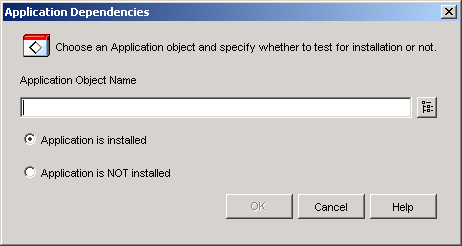
Application Object Name
Browse to and select the application whose existence on the workstation Application Launcher will check for.
Application Is Installed
Select this option to indicate that the selected application must already be installed on the workstation.
Application Is Not Installed
Select this option to indicate that the selected application must not be installed on the workstation.
Client
The Novell Client Rule dialog box page > > ), shown below, lets you base distribution on whether or not the Novell Client is installed on the workstation.
Figure 48-27 Novell Client Rule Dialog Box
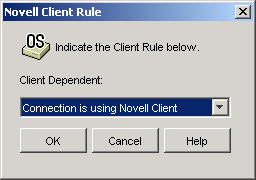
Client Dependent
Select if you want the application to be available only on workstations that are running the Novell Client.
Select if you want the application to be available only workstations that are not running the Novell Client.
Connection Speed
The Connection Speed Rule dialog box ( page > > ) lets you base distribution on the speed of the workstation’s network connection.
For example, if you don’t want the application to be available on remote workstations whose connection speed is less than 56 Kbps, you could require a connection speed of 56 Kbps or greater.
Figure 48-28 Connection Speed Rule Dialog Box
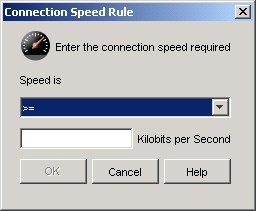
Speed Is (Conditional Statement)
Select whether the connection speed must be less than (<), less than or equal to (<=), greater than (>), or greater than or equal to (>=) the speed entered in the Kilobits per Second field.
Kilobits per Second (Condition)
Specify the connection speed in kilobits per second.
Disk Space
The Disk Space Rule dialog box ( page > > ), shown below, lets you base distribution on the workstation's free disk space. This ensures that Application Launcher does not attempt to distribute an application to a workstation that does not have sufficient free disk space.
Figure 48-29 Disk Space Rule Dialog Box
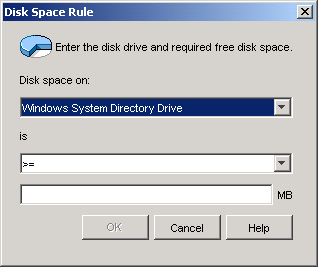
Disk Space On
Select the disk where you are requiring free space. The list includes the following options:
-
A through Z: Allows you to select the disk that is mapped to drive A, B, C, and so on.
-
Windows system directory drive: Allows you to select the disk where the Windows system directory (for example, winnt\system32) resides.
-
Windows directory drive: Allows you to select the disk where the Windows directory (for example, winnt) resides.
-
Temp directory drive: Allows you to select the disk where the Windows temporary directory (for example, winnt\temp) resides.
If you create multiple disk space requirements for the application, Application Launcher adds the requirements together to determine the total disk space requirement. For example, if you specify 20 MB free on the Windows directory drive (which happens to be the C: drive), 10 MB free on the temp directory drive (which is also the C: drive), and 50 MB free on the D: drive, Application Launcher distributes the Application object only if there is 30 MB available on the C: drive and 50 MB free on the D: drive.
Is (Conditional Statement)
Select whether the available disk space must be less than, less than or equal to, equal to, greater than, greater than or equal to the amount listed in the MB field. The corresponding operators are as follows:
- Less than: <
- Less than or equal to: <=
- Equal to: =
- Greater than or equal to: >=
- Greater than: >
For example, if you want to require at least 50 MB of free disk space, select >= (greater than or equal to) and then enter 50 in the MB field.
MB (Condition)
Specify the disk space requirement.
Environment Variables
The Environment Variable Rule dialog box ( page > > ), shown below, lets you base distribution on whether or not an environment variable containing specific data exists.
Figure 48-30 Environment Variable Rule Dialog Box
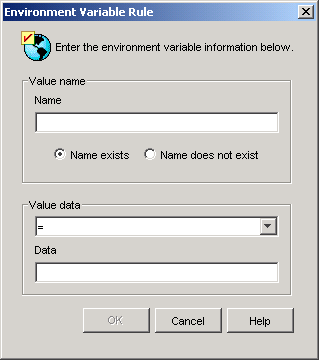
Value Name
Specify the name of the environment variable. Select the option to require the variable to already exist on the workstation, or select the option to require the variable to not exist on the workstation.
Value Data
Specify whether the variable data must be equal to, not equal to, contain, or not contain the data you enter in the Data field.
File Date
The File Date Rule dialog box ( page > > ), shown below, lets you base distribution on the date of a specific file located on the workstation.
Figure 48-31 File Date Rule Dialog Box
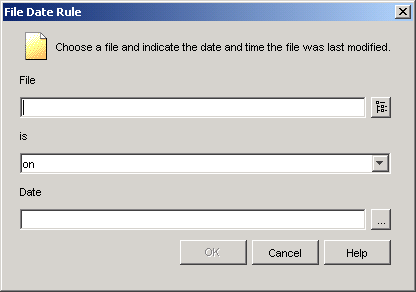
File
Browse to select the file whose date Application Launcher will check.
Is (Conditional Statement)
Select whether the file date must be before, on or before, on, on or after, or after the date entered in the field. For example, if you want to make sure the application is distributed only if the file is dated 15 January 2000 or older, you would select and then select the date.
Date (Condition)
Use the Calendar to select the appropriate date.
File Existence
The File Existence Rule dialog box ( page > > ), shown below, lets you base distribution on whether or not a specific file exists on the workstation.
Figure 48-32 File Existence Rule Dialog Box
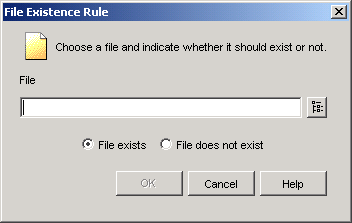
File
Browse and select the file that Application Launcher will check for.
File Exists
Select this option to require the file to exist on the workstation.
File Does Not Exist
Select this option to require the file to not exist on the workstation.
File Size
The File Size Rule dialog box ( page > > ), shown below, lets you base distribution on the size of a specific file located on the workstation.
Figure 48-33 File Size Rule Dialog Box
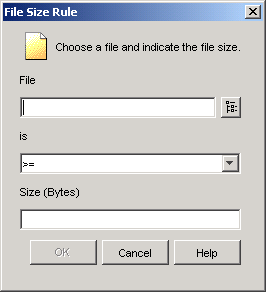
File
Browse to select the file whose size Application Launcher will check.
Is (Conditional Statement)
Select whether the size must be less than, less than or equal to, equal to, greater than, or greater than or equal to the size entered in the Size field. The corresponding operators are as follows:
- Less than: <
- Less than or equal to: <=
- Equal to: =
- Greater than or equal to: >=
- Greater than: >
For example, if you want to require the file to be at least 200 KB, select >= (greater than or equal to) and then enter 200000 in the Size field.
Size
Specify the file size in kilobytes.
File Version
The File Version Rule dialog box ( page > > ), shown below, lets you base distribution on the version of a specific file located on the workstation.
Figure 48-34 File Version Rule Dialog Box
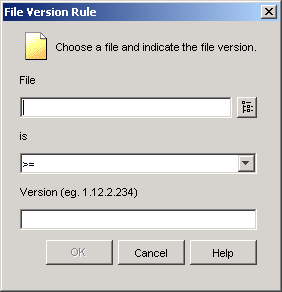
File
Browse to select the file whose version you want Application Launcher to check.
Is (Conditional Statement)
Select whether the version must be less than, less than or equal to, equal to, greater than, greater than or equal to the version entered in the Version field. The corresponding operators are as follows:
- Less than: <
- Less than or equal to: <=
- Equal to: =
- Greater than or equal to: >=
- Greater than: >
For example, if you want to require at least version 1.12.2.234, select >= (greater than or equal to) and then enter 1.12.2.234 in the Version field.
Version (Condition)
Specify the file version.
Memory
The Memory Rule dialog box ( page > > ), shown below, lets you base distribution on the amount of memory (RAM) required on the workstation.
Figure 48-35 Memory Rule Dialog Box
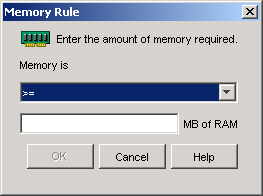
Memory Is (Conditional Statement)
Select whether the total memory must be less than, less than or equal to, equal to, greater than, greater than or equal to the memory entered in the MB of RAM field. The corresponding operators are as follows:
- Less than: <
- Less than or equal to: <=
- Equal to: =
- Greater than or equal to: >=
- Greater than: >
For example, if you want to require at least 32 MB of free RAM, select >= (greater than or equal to) and then enter 32 in the MB of RAM field.
MB of RAM (Condition)
Specify the required memory amount.
Operating System
The Operating System Rule dialog box page > > ), shown below, lets you base distribution on the workstation's operating system and version.
Figure 48-36 Operating System Rule Dialog Box
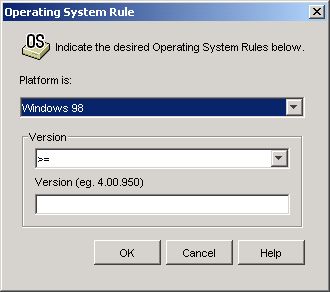
Platform Is
Select the operating system (Windows 98 or Windows NT/2000/XP) the workstation must be running.
NOTE:The requirement for an operating system to be defined before an application is available has been removed.
In previous ZENworks versions, an OS platform had to be defined in the System Requirements before an application was available for distribution and launching. This requirement has been removed.
The new behavior uses the following logic: If an application runs only on a specific operating system, define an operating system distribution rule. If an application does not require a specific operating system, there is no need to define a distribution rule. By default, applications without a defined operating system distribution rule are available on all supported platforms (Windows 98, Windows 2000, and Windows XP).
Version
Select whether the version number must be less than, less than or equal to, equal to, greater than, greater than or equal to the number entered in the Version field.
- Less than: <
- Less than or equal to: <=
- Equal to: =
- Greater than or equal to: >=
- Greater than: >
For example, if you want to require at least version 4.00.950, select >= (greater than or equal to) and then enter 4.00.950 in the Version field.
Processor
The Processor Rule dialog box ( page > > ), shown below, lets you base distribution on the workstation's processor.
Figure 48-37 Processor Rule Dialog Box
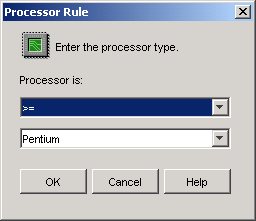
Processor Is
Select whether the processor must be less than, less than or equal to, equal to, greater than, or greater than or equal to the processor type (386, 486, Pentium, Pentium Pro, Pentium II, Pentium III) selected in the processor list.
- Less than: <
- Less than or equal to: <=
- Equal to: =
- Greater than or equal to: >=
- Greater than: >
For example, if you want to require at least a Pentium II processor, select >= (greater than or equal to) and then select Pentium II.
Registry
The Registry Rule dialog box ( page > > ), shown below, lets you base distribution on whether or not a specific registry key or value exists.
Figure 48-38 Registry Rule Dialog Box
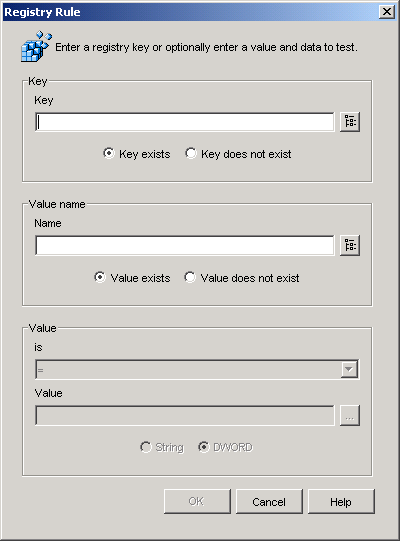
Key
Browse and select the registry key you want to check before distribution. Select if the key must exist for the distribution to take place, or select if the key cannot exist for the distribution to take place.
Name
If the key has a specific value you want to check for, browse and select the value. Select if the value must exist for the distribution to take place, or select if the value cannot exist for the distribution to take place.
Value
If you specified a value in the field, select an operator (<, <=, =, !=, >=, >) for the value's data, enter the data in the field, then select whether the value data is a String or DWORD type.
The operator definitions are as follows:
- Less than: <
- Less than or equal to: <=
- Equal to: =
- Greater than or equal to: >=
- Greater than: >
Remote Access
The Remote Access Rule dialog box ( page > > ), shown below, lets you base distribution on whether Application Launcher is in remote mode or local (LAN) mode. The method Application Launcher uses to detect which mode it is in is determined by the Remote Access Detection setting (User/Workstation/container object > tab > page > button > tab).
Figure 48-39 Remote Access Rule Dialog Box
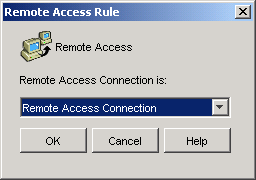
Remote Access Connection Is
Select whether the connection must be a remote access connection or a LAN connection. For example, if you select , the application is distributed to a user only if Application Launcher is running in remote mode.
Terminal Server
The Terminal Server Rule dialog box ( page > > ), shown below, lets you base distribution on whether or not the machine is a terminal server (in other words, Windows Terminal Services is active on the machine).
Figure 48-40 Terminal Server Rule Dialog Box
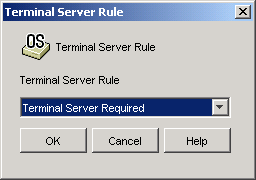
Select if you want the application to be distributed only to terminal servers. Select if you want the application to be distributed only to non-terminal servers.
48.5.2 Schedule Page
The Schedule property page is available on Application objects created for all application types (simple, AOT/AXT, MSI, Web, and terminal server).
The Schedule property page, shown below, defines the dates and times when the application is available to users. Application Launcher displays the application icon only during the times defined by the schedule.
The schedule applies regardless of whether or not the application is installed. For example, if a user has not yet installed the application, it is only available for installation at the times specified by the schedule. Likewise, if a user has already installed the application, it is only available for running during the scheduled times.
Figure 48-41 Application Object > Availability Tab > Schedule Page

Schedule Type
Select the type of schedule you want to use. You can choose , , or .
None
Use this option to indicate no schedule. The Application object becomes available to an object as soon as the application’s system requirements have been established ( > page) and the application has been associated with the object ( page).
Specified Days
Use this option to select specific dates when you want the Application object to be available. After selecting this option, fill in the following fields:
-
Date range: The Date Range list displays all dates when the Application object is available. To add a date, click > select the date you want > click to display it in the list. You cannot select more than 350 specific dates.
-
Time for selected dates: Select the availability start time and end time. The times apply to all dates in the Date Range list.
NOTE:The time increments in 5 minute intervals, with the earliest available start time being 00:00 (12:00 a.m.) and the latest end time being 23:55 (11:55 p.m.). This means there is always a 5-minute time period from 11:55 p.m. to 12:00 midnight when the application is unavailable. If you want the application to be available the entire day, you need to use the schedule type. For more information, see Range of Days.
-
Spread from start time (in minutes): The option spreads out user access times over the number of minutes specified so the application doesn’t become available to all users at the same time. If you anticipate all users launching the application as soon as it becomes available and the application is being distributed or run from the network, you can use this option to avoid possible network overload.
For example, if you have a moderate number of users to whom the application is to be distributed (say about 100), you might specify a one-hour (60 minute) block of time (starting at the scheduled start time) to randomly distribute the application: thus all users will gain access to the application some time during the first sixty minutes after the scheduled start time.
If you want to substantially ease the load on your servers caused by the application distribution, or if you have bandwidth concerns, you might want to make the application distribute randomly throughout the time of availability. To spread out access times across the entire time ( and ) that the application is available, use the total availability time specified for that application in terms of minutes. This will require that you make the maximum time available for each day you specify. For example, if an application is configured for a typical business day in the United States (9 hours per day: 8:00 a.m. to 5:00 p.m.), you calculate the total time of availability for that application like this:
Number of specified hours x 60 minutes per hour = Total availability time per day
Using this equation, the example above would be calculated like this:
9 x 60 (minutes per hour) = 540 minutes of availability
In this example, when you enter 540 minutes in the field, the application is distributed randomly for the entire 540 minutes that you have made it available on that scheduled day. Note that this might not be suitable for applications that must be distributed in a timely fashion, such as anti-virus updates. Note also that this is an example only: you can schedule the distribution for any specified amount of time for any day of the week.
Remember that the setting makes the last five minutes of a day unscheduleable, so you need to consider these five minutes if the application schedule ends at 11:55 p.m. for that day.
Range of Days
Use this option to select a range of dates to make the application available. You can also use this option to make applications available only on certain days of the week within a given range of dates. After selecting this option, fill in the following fields:
-
Date range: To define the range of days, select a start date and an end date, then select the days (Sunday through Saturday) within the established date range that the application is available. By default, all days are selected; a day is selected when the button appears to be pressed in.
-
Time for selected range: Select the availability start time and end time. This option works differently depending on whether the date range includes one day, multiple days, or all seven days. If the date range includes one to six days (but not all seven days), the application is available between the start and end times on those days. For example, if you make the application available on Monday between 8:00 and 5:00, it is available during those hours. However, if the date range includes all seven days, the times are ignored and the application is available every day, 24 hours a day.
-
Spread from start time (in minutes): The option spreads out user access times over the number of minutes specified so the application doesn't become available to all users at the same time. If you anticipate all users launching the application as soon as it becomes available and the application is being distributed or run from the network, you can use this option to avoid possible network overload.
For example, if you have a moderate number of users to whom the application is to be distributed (say about 100), you might specify a one-hour (60 minute) block of time (starting at the scheduled start time) to randomly distribute the application: thus all users will gain access to the application some time during the first sixty minutes after the scheduled start time.
If you want to ease the load of the application distribution on your servers or if you have bandwidth concerns, you might want to make the application distribute randomly throughout the time of availability. To spread out access times across the entire time ( and ) that the application is available, use the total availability time specified for that application in terms of minutes. For example, if a workstation-associated application is configured for an entire 24-hour, three-shift day, you can calculate the total time of availability for that application like this:
Number of days in date range x Time of availability per day = Total availability time
Using this equation, and making sure to convert hours to minutes, the example above would be calculated like this:
7 (days) x 24 (hours) = 168 hours of availability
168 x 60 (minutes per hour) = 10,080 minutes of availability
When you enter 10800 minutes in the field, the application is distributed randomly for the entire10800 minutes that you have made it available. Note that this is not suitable for applications that must be distributed in a timely fashion, such as anti-virus updates.
-
Use this schedule in GMT for all clients: The schedule is based on the workstation's time zone. If your network spans different time zones and you schedule an application to run at 1:00 p.m., it runs at 1:00 p.m. in each time zone. You can select this option to have workstations run applications at the same time regardless of their time zones (for example, 1:00 p.m. Rome time and 4:00 a.m. Los Angeles time).
48.5.3 Termination Page
The Termination property page is available on Application objects created for all application types (simple, AOT/AXT, MSI, Web, and terminal server).
The Termination property page, shown below, determines how Application Launcher terminates the application if it becomes unavailable to a user while the user is running the application. An application becomes unavailable to a user when:
-
You disassociate it from the user.
-
The availability schedule expires.
-
The application’s distribution rules change and the user's workstation no longer complies with the requirements.
Figure 48-42 Application Object > Availability Tab > Termination Page
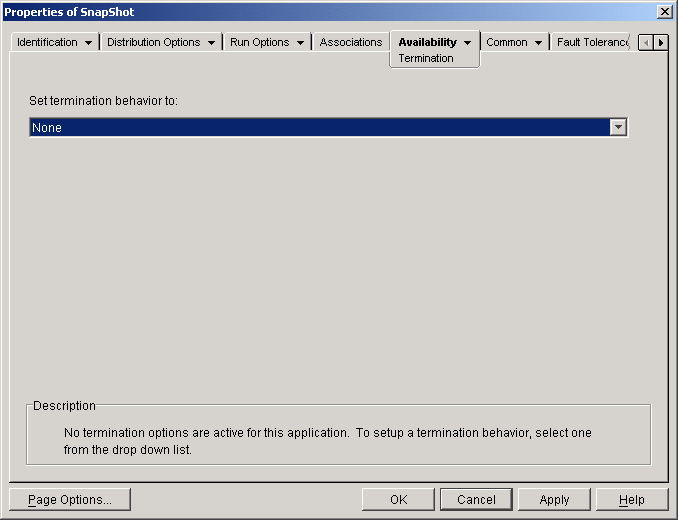
Set Termination Behavior To
Select the behavior you want used when the application terminates.
None
Select this option to disable any termination behaviors.
Send Message to Close Application
This option causes Application Launcher to display a message instructing the user to close the application. The message appears periodically until the user closes the application.
In the Basic Closing Message box, select how often you want Application Launcher to display the message. The following default message is used unless you click the Message button and define a custom message:
WARNING! Your access to this application has expired. Please close the application to avoid losing your work.
Send Message to Close Then Prompt to Save Data
This option causes Application Launcher to first display a message instructing the user to close the application. If the user does not close the application, Application Launcher sends a call to the application instructing it to close. If the user has no unsaved data, the application closes immediately. If the user has unsaved data, the application displays a Save dialog box to allow the user to save the data. After the application closes, users cannot launch it again.
IMPORTANT:Some applications display a Save dialog box that includes a button in addition to and buttons. The button aborts the close operation and the application remains open. If the application’s Save dialog box includes a button and you want to ensure that the application is closed, you must use the , , Then option.
After selecting this option, fill in the following fields:
-
Warning message (optional): Select the option if you want to warn the user to close the application, then specify the number of times to display the warning message and the interval between messages. The following default message is used unless you click the button and define a custom message:
WARNING! Your access to this application has expired. Please close the application to avoid losing your work.
-
Prompt closing message: This message is displayed if the user does not close the application after receiving the warning message the specified number of times, or if the warning message option is not enabled.
In the Prompt Closing Message box, specify how often you want to prompt the user to close the application. If, after receiving the prompt, the user does not close the application, Application Launcher attempts to close the application. The following default message is used unless you click the button and define a custom message:
WARNING! Your access to this application has expired and the application will close shortly. Please save your work and exit the application.
Send Message to Close, Prompt to Save, Then Force Close
This option causes Application Launcher to first display a message instructing the user to close the application. If the user does not close the application, Application Launcher sends a call to the application instructing it to close. If the user has no unsaved data, the application closes immediately. If the user has unsaved data, the application displays a Save dialog box to allow the user to save the data. Regardless of the option (, , ) the user selects, the application is closed.
After selecting this option, fill in the following fields:
-
Warning message (optional): Select the option if you want to warn the user to close the application, then specify the number of times to display the warning and the interval between warnings. The following default message is used unless you click the button and define a custom message:
WARNING! Your access to this application has expired. Please close the application to avoid losing your work.
-
Prompt closing message: This message is displayed if the user does not close the application after receiving the warning message the specified number of times, or if the warning message option is not enabled.
In the Prompt Closing Message box, specify how often you want to prompt the user to close the application. If, after receiving the prompt, the user does not close the application, Application Launcher attempts to close the application. The following default message is used unless you click the button and define a custom message:
WARNING! Your access to this application has expired and the application will close shortly. Please save your work and exit the application.
-
Application termination: This message is displayed after Application Launcher closes the application. If you don’t want to use the default termination message, click the button and define a custom message. The default message is:
The application you were running has expired. For additional usage, please contact your system administrator.
Send Message to Close Then Force Close with Explanation
This option prompts the user to close the application. If the user does not, Application Launcher closes the application automatically and displays a termination message.
After selecting this option, fill in the following fields:
-
Warning message (optional): Select the option if you want to warn the user to close the application, then specify the number of times to display the warning and the interval between warnings. If the user does not close the application, Application Launcher closes the application automatically after the last warning message. The following default message is used unless you click the button and define a custom message:
WARNING! Your access to this application has expired. Please close the application to avoid losing your work.
-
Application termination: This message is displayed after Application Launcher closes the application. If you don’t want to use the default termination message, click the button and define a custom message. The default message is:
The application you were running has expired. For additional usage, please contact your system administrator.